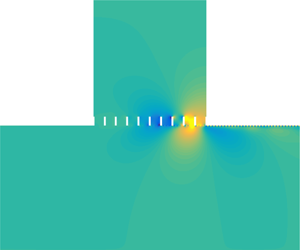Article contents
Flow–acoustic resonance in a cavity covered by a perforated plate
Published online by Cambridge University Press: 03 December 2019
Abstract

To explain the large-scale hydrodynamic instability along a cavity-backed perforated plate in a flow duct, a two-dimensional multimodal analysis of flow disturbances is performed. First, a hole-by-hole description of the perforated plate shows a spatially growing wave with a wavelength close to the plate length, but much larger than the period of perforation. To better understand this problem and also cavity flow oscillations, we then combine the travelling mode and global mode analyses of the flow where the plate is represented by a homogeneous impedance. The spatially growing wave is, from a homogeneous point of view, essentially a Kelvin–Helmholtz instability wave, strongly distorted by evanescent acoustic waves near the cavity downstream edge. The phase difference of the unstable hydrodynamic mode at the two edges is found to be a bit larger than  $2\unicode[STIX]{x03C0}$, whereas the upstream-travelling evanescent waves reduce the total phase change around the feedback loop, so that the phase condition of the global mode can still be satisfied. This particular case indicates the significant effects of those evanescent waves on both the amplitude and phase of cavity flow disturbances. The criterion of the global instability is discussed: the loop gain being larger or smaller than unity determines whether the global mode is unstable or stable. A global mode in the stable regime, which has so far received little attention, is explored by investigating the system response to external forcing. It is shown that sound can be produced when a lightly damped flow–acoustic resonance is excited by a vortical wave.
$2\unicode[STIX]{x03C0}$, whereas the upstream-travelling evanescent waves reduce the total phase change around the feedback loop, so that the phase condition of the global mode can still be satisfied. This particular case indicates the significant effects of those evanescent waves on both the amplitude and phase of cavity flow disturbances. The criterion of the global instability is discussed: the loop gain being larger or smaller than unity determines whether the global mode is unstable or stable. A global mode in the stable regime, which has so far received little attention, is explored by investigating the system response to external forcing. It is shown that sound can be produced when a lightly damped flow–acoustic resonance is excited by a vortical wave.
JFM classification
- Type
- JFM Papers
- Information
- Copyright
- © 2019 Cambridge University Press
References
- 8
- Cited by




